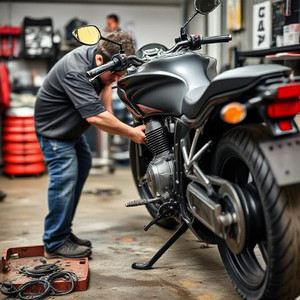Motorcycle maintenance isn’t just about keeping your bike looking clean — it’s a vital part of making sure you stay safe on the road. Extend your motorcycle’s lifespan, and get the best performance out of every ride. Regardless of what types of bikes you are maintaining, Whether you’re commuting daily, touring long distances, or riding for leisure on weekends, a properly maintained bike runs better, is safer, and saves you money in the long run. Keeping your motorcycle from repair shops and saves you bike from unskilled motorcycle mechanic.
In this article, we’ll break down 10 important must-check points when maintaining a motorcycle that every responsible rider should know.

1. Engine Oil and Filter
Your motorcycle’s engine oil acts as the blood of your bike, lubricating moving parts, reducing friction, and preventing overheating. Old or dirty oil can cause engine damage and reduce performance.
What to check:
Oil level via dipstick or sight glass.
Oil color (shouldn’t be too dark or dirty).
Oil change intervals based on your owner’s manual.
Replace oil filter along with every oil change.
Check oil leaks and oil seals.
Tip: Regularly check and change your oil — usually every 3,000 to 5,000 kilometers or as recommended by your manufacturer.

2. Tire Condition and Pressure
Your tires are your only contact point with the road, so it’s crucial they’re always in good shape. It’s as important as your motorcycle engine when you are on the road.
What to check:
Tire pressure (use a reliable gauge, follow the recommended PSI).
Tread depth — replace if worn down.
Look for cracks, punctures, or uneven wear.
Ensure tire is properly fitted in the rim.
Tip: Always check your tire pressure before long rides, and remember, tire pressure affects handling and fuel efficiency.

3. Brake Pads and Fluid
Safe stopping power is non-negotiable for any rider. Faulty brakes can lead to dangerous situations. Brake pads and fluid dictates your safety while hitting the road on two wheels.
What to check:
Brake pad thickness (replace when less than 2-3mm).
Brake fluid level and color (should be clear and within the reservoir’s marked levels).
Brake levers and pedal responsiveness.
Tip: Brake fluid should be replaced every 1-2 years or as recommended in your manual.

4. Chain and Sprockets
Your motorcycle’s chain transfers power from the engine to the rear wheel. A neglected chain can snap or wear out other parts. Ensure chain and sprocket’s compatibility. A correct combination makes a smooth and speedy ride.
What to check:
Chain tension (usually 20-30mm of slack depending on your bike model).
Lubrication (apply chain lube every 500-800 km or after rain rides).
Look for signs of rust, stiff links, or excessive wear on sprockets.
A dry and rusty chain makes it noisy, that’s irritating to hear as you ride.
Tip: Clean your chain regularly with a soft brush and motorcycle chain cleaner before re-lubricating.

5. Battery Health
Without a healthy battery, your bike won’t start, no matter how good everything else is. Be always sure that your battery can sustain your bike the entire long ride.
What to check:
Battery terminals for corrosion.
Charge level (use a multimeter, it should read around 12.6V when fully charged).
Check for cracks or bulges on the battery casing.
Tip: If you’re not riding for a while, use a trickle charger to maintain your battery.

6. Lights and Signals
Proper visibility and communication with other motorists are essential for your safety.
What to check:
Headlight (low and high beam function).
Brake light.
Turn signals.
License plate light.
Tip: Check all lights before every ride, especially if riding at night or in bad weather.

7. Coolant Level (For Liquid-Cooled Bikes)
Overheating can damage your engine. For liquid-cooled bikes, maintaining the correct coolant level is vital.
What to check:
Coolant reservoir level (when engine is cold).
Look for leaks or worn hoses.
Check coolant color — replace if it looks dirty or has particles.
Tip: Replace coolant every 2 years or per your bike’s maintenance schedule.

8. Air Filter
A clean air filter ensures your engine breathes properly, affecting both performance and fuel efficiency.
What to check:
Dirt build-up or clogging.
Clean or replace if heavily soiled.
Tip: Check your air filter every 5,000 km (more often if riding in dusty areas).
9. Clutch and Throttle Operation
Smooth clutch and throttle action are essential for safe and comfortable riding.
What to check:
Free play in clutch lever and throttle (usually around 2-3mm).
Smooth and responsive operation.
Adjust or lubricate cables if needed.
Tip: Avoid over-tightening the clutch lever as it can lead to clutch slippage.

10. Suspension and Steering
Your bike’s handling depends heavily on its suspension and steering system. It is the one that manipulates the balance and direction of where you’re intended to go on the road.
What to check:
Front fork seals for oil leaks.
Rear shock absorber condition.
Steering head bearings (no play or tight spots when turning the handlebars).
Tip: If your ride feels unstable or bottoms out over bumps, it’s time to check or service the suspension.

Final Thoughts
Motorcycle maintenance doesn’t have to be intimidating. With regular checks and a little care, you can keep your bike running smoothly, stay safe, and avoid expensive repairs. Most of these tasks are easy to do at home, while some might require a visit to your trusted mechanic.
Remember: A well-maintained motorcycle is not just about longevity — it’s about safety, performance, and enjoying every kilometer you ride.
- 10 Important Must-Check Points in Maintaining a Motorcycle
- Holy Thursday Ride: Mother of All Asia, Lobo Batangas
- Booming Motorcycle Sales / Industry in the Philippines (2025)
- 12 Important Traits of a Responsible Motorcycle Rider
- 10 Important Road Signs Every Motorcycle Rider Should Know
visit http://ditokayshellan.com for more budgetarian travel insights, Mountain climbs, and motocamping.
back to Homepage

